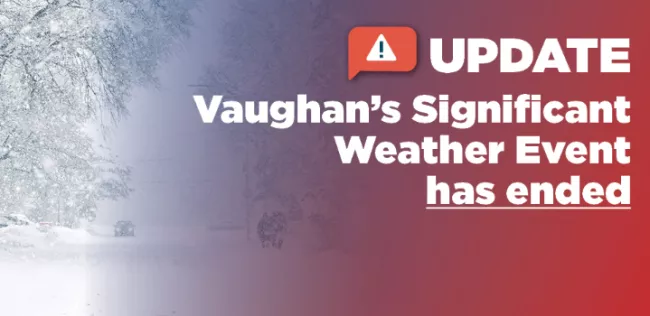Vaughan’s Significant Weather Event has ended
Update: the Significant Weather Event has ended as of Monday,
Dec. 26.
The City of Vaughan declared a Significant Weather Event based on a winter storm warning issued by Environment Canada on Thursday, Dec. 22. Conditions were favourable for five to 15 centimetres of snow and wind gusts up to 90 kilometres per hour. A drop in temperature was also expected to lead to a potential flash freeze producing icy and slippery surfaces in areas that receive rainfall.
The City encouraged drivers to be cautious and adjust their driving according to changing road conditions and visibility. Precautions included avoiding unnecessary travel and taking frequent breaks when shovelling snow to avoid overexertion.
The City has a fleet of more than 230 vehicles – including salter/snowplow units, windrow machines, sidewalk machines, pickup trucks equipped with plows and salters, cul-de-sac-clearing machines and anti-icing units – to ensure citizens are provided with high-quality winter services.
Due to the forecasted conditions, it may have taken longer than usual to clear City roads, sidewalks and/or bicycle lanes. Staff continue to monitor weather forecasts and make the necessary decisions and adjustments to operations.
A Significant Weather Event is defined as an approaching or occurring weather hazard with the potential to pose a significant danger to users of the highways within a municipality. Examples of severe weather include freezing rain, significant snowfall, blowing snow and reduced visibility. The Ontario Regulation 239/02, Minimum Maintenance Standards for Municipal Highways allows municipalities to declare a Significant Weather Event when Environment Canada issues a weather alert and when that weather hazard has the potential to pose a significant danger to users of the highways which they have authority over.
HOW YOU CAN HELP
Help winter operations run effectively and efficiently by following these tips:
- Keep cars off the street while snowplows are out to assist the City in ensuring streets are cleared properly and safely. On-street parking is not permitted between 2 a.m. and 6 a.m. in Vaughan.
- Clear snow and ice from sidewalks bordering your property as soon as a snowfall has ended to help ensure roads and sidewalks remain safe, as stated in the City’s Snow-Clearing By-law 227-2022 (PDF).
- Remove anything that may interfere with or be hazardous to plow crews. This includes landscaping features, such as fencing, basketball nets, decorative stones, pots, bird baths, furniture and more, as stated in the City’s Encroachment By-law 034-2017 (PDF). These items should be within 30 centimetres of a sidewalk or within one metre of a street curb.
- Be mindful of where snow is placed. It is illegal to shovel snow or ice onto the road under the Ontario Highway Traffic Act and the City’s Dumping By-law (PDF).
- Stay off the roads during a heavy snowstorm unless travel is essential. You can also use York Region Transit to get around the city during inclement weather.
- Clean snow off all surfaces of your vehicle before driving and keep a safe distance away from snowplows and salting equipment.
- Set waste bins back from the curb approximately one metre on the right-hand side of your driveway, where possible (when facing the home). They should never be placed on top of or behind snowbanks.
- Keep fire hydrants clear and accessible (one metre all around). Blocked, concealed or difficult-to-access fire hydrants can slow down emergency fire response. As outlined in the City’s Water By-law 106-2022 (PDF), citizens who have a fire hydrant on their property or City property adjacent to theirs are responsible for ensuring the hydrant is always visible and unobstructed.
- Help keep catch basins clear of snow and ice to prevent flooding during temperature fluctuations if it’s safe to do so.
MORE INFORMATION
For additional details and to receive the latest information on Vaughan’s winter operations:
- visit vaughan.ca/snow
- contact the Snow Hotline at 905-879-SNOW (7669) or email snow@vaughan.ca
- follow the City’s official corporate channels on Twitter, Facebook, Instagram and LinkedIn
- subscribe
to Vaughan
News

